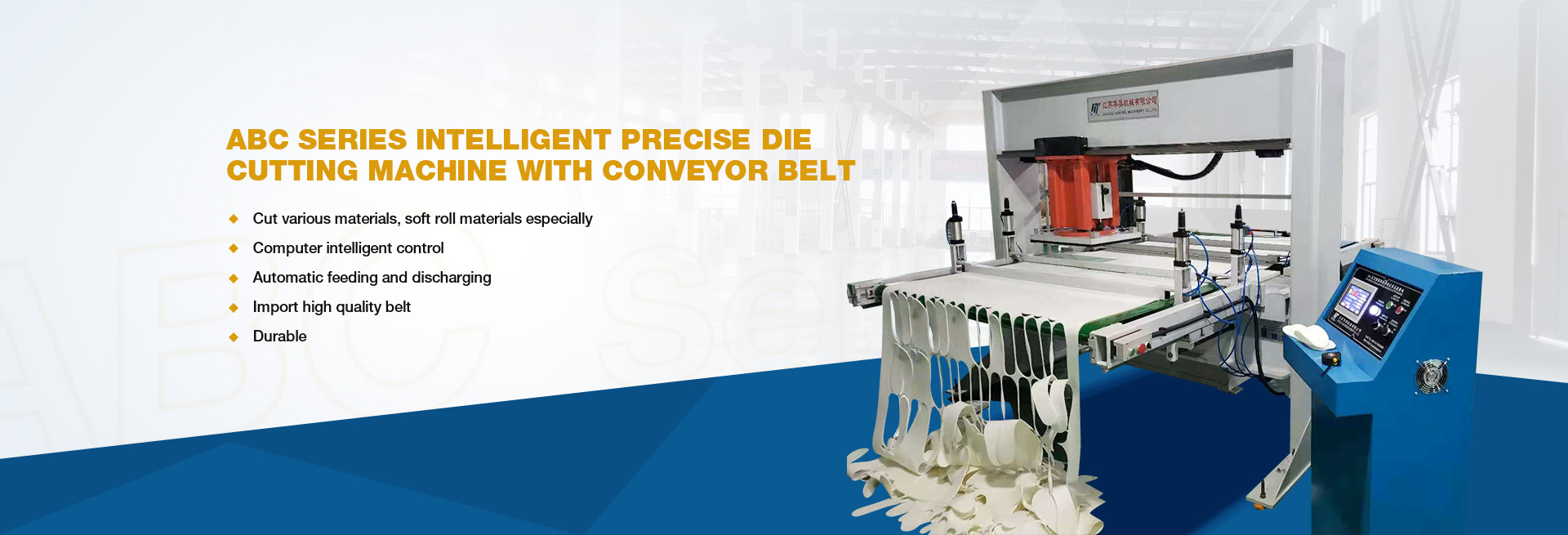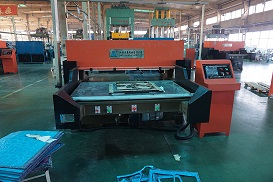The circumference of the cutting cutter mold determines the tonnage size of the oil pressure cutting machine. The workflow of the cutting machine is to cut the material into the required shape by means of the machine movement. Because of its wide use, customers need to shape and size, a variety of tonnage cutting machine pressure size because of the oil pump displacement and the size of the diameter of the cylinder, so we should be careful when choosing, so as not to produce unnecessary losses.
1. The size of the knife mold is within 10cm * 10cm, such as in the leather trademark industry, children’s shoes production, etc., choose about 8 tons of hydraulic rocker arm can be cut.
2. The size of the knife mold is within 10cm * 20cm, such as in the insole sole, small crafts, etc. It is recommended to choose 12 tons of cutting machine.
3. The size of the knife mold is within 20 * 30cm, such as if you want to make the upper, mouse pad, electronic products, canvas gloves, you can choose 20 tons of rocker arm oil pressure cutting machine.
4. The knife mold size is greater than 30 * 30cm, such as bags, bags, clothing, glass fiber, packaging, automobile interior and other industries can choose the plane cutting machine or precision four-pillar cutting machine.
5. Plastic absorption industry according to the characteristics of the industry, the width of 1200mm, but the travel requirements of 20cm, the upper and lower height is higher, the general cutting machine travel can not meet its requirements, we strong Cheng machinery according to this characteristic of professional development of suction plastic cutting machine its upper and lower press distance of 240mm, adjustable travel 20cm fully meet this requirement, for customers to choose.
In addition, the food industry such as chocolate, bread and so on do not need much pressure, but the width of the board must be covered with the knife
Some customers don’t understand, choose oil pressure cutting machine just consider the price factor, put the big knife size on the small machine operation, always feel can pressure, first can pressure, who know not after a long time, the machine will produce insufficient pressure, or leakage, or oil pump rupture, the machine maintenance costs, serious machine bed rupture, oil pressure cutting machine scrap loss is bigger. Therefore, in the investment, choose the right suitable for their own products is to really create benefits for themselves.
The role of heat treatment in cutting machinery manufacturing industry
The purpose of heat treatment of hydraulic cutting machine is to improve the mechanical properties of materials, eliminate residual stress and improve the cutting of metal. According to the different purposes of heat treatment, the heat treatment process can be divided into two categories: preparatory heat treatment and final heat treatment.
1. Prepare for heat treatment
The purpose of preparatory heat treatment is to improve processing performance, eliminate internal stress and prepare good metallographic organization for final heat treatment. The heat treatment process has annealing, regular ignition, aging, quality regulation and so on.
(1) Annealing and ignition of cutting machine annealing and ignition are used for hot processed blanks. Carbon steel and alloy steel with carbon content are often used to reduce the hardness; carbon steel and alloy steel with carbon content below 0.5% are used to avoid adhesive knife with low hardness. Annealing and ignition can refine the grain and organize evenly, and prepare for future heat treatment. Annealing and normalizing are often arranged after the manufacture of rough work and before rough machining.
(2) aging treatment aging treatment is mainly used to eliminate the internal stress generated in blank manufacturing and machining. In order to avoid excessive transportation workload, for the general precision parts, a time treatment can be arranged before finishing. However, the parts with high precision requirements (such as the box of the seat mark boring machine, etc.) should be arranged for two or several aging procedures. Simple parts are generally not limited processing. In addition to castings, for some precision parts with poor rigidity (such as precision wire), in order to eliminate the internal stress generated in processing and stabilize the processing accuracy of parts, it is often arranged between rough processing and semi-precision processing. Some shaft parts processing, in the calibration process is also arranged after the time processing.
(3) Quality adjustment is high temperature tempering treatment after quenching, it can obtain uniform and meticulous tempering soordite tissue, for the future surface quenching and nitriding treatment to reduce deformation, so quality adjustment can also be used as preparatory heat treatment.
Due to the good comprehensive mechanical properties of the parts after quality adjustment, some parts with low hardness and wear resistance requirements can also be used as the final heat treatment process.
2. Final heat treatment
The purpose of the final heat treatment of the oil pressure cutter is to improve the mechanical properties such as hardness, wear resistance and strength.
(1) Quenching quenching with surface quenching and overall quenching. Among them, surface quenching is widely used due to small deformation, oxidation and decarbonization, and surface quenching also has the advantages of high external strength, good wear resistance, and good internal toughness and strong impact force resistance. In order to improve the mechanical properties of surface quenching parts, heat treatment such as tempering or regular ignition is often required as preparatory heat treatment. Its general process route is: cutting —— forging —— ignition (annealing) —— rough machining —— conditioning —— semi-finishing —— surface quenching —— finishing.
(2) Carburizing quenching Carburizing quenching is suitable for low carbon steel and low alloy steel, first improve the carbon content of the surface of the parts, after quenching the surface to obtain high hardness, and the heart still maintains a certain strength and high toughness and plasticity. Carburization into overall carburization and local carburization. When local carburization, anti-seepage measures should be taken (copper plating or anti-seepage materials). Due to the large deformation of carburization quenching, and the depth of carburization is generally between 0.5 and 2 mm, so the carburization process is generally arranged between semi-finishing and finishing. The process route is generally: cutting-forging-positive ignition-coarse, semi-finishing processing-carburization quenching-finishing processing.
When the non-carburizing part of the local carburizing parts adopts the process scheme of removing the excess carburizing layer, the process of removing the excess carburizing layer should be arranged after carburization and before quenching.
(3) Nitriding treatment Nitriding is a treatment method to make nitrogen atoms penetrate into the metal surface to obtain a layer of nitrogen-containing compounds. Nitriding layer can improve the hardness, wear resistance, fatigue strength and corrosion resistance of the parts. Due to the low nitrogen infiltration treatment temperature, small deformation, and the thin nitrogen infiltration layer (generally not more than 0.6~ 0.7mm), the nitrogen infiltration process should be arranged as far as possible. In order to reduce the deformation of the nitrogen infiltration, the high temperature tempering to eliminate stress is generally required after cutting.
The concept of cutting machine heat treatment is very big in order to make the hardness of the material, material meet the processing needs to heat treatment, heat treatment including quenching (make material hardness), quality, effective (make the stress elimination in mechanical processing), annealing (make the hardness drop to machining), galvanized (surface treatment rust), chrome plating (surface treatment rust), carburizing (surface hardening) blue (surface treatment rust) heat treatment has a very important position for mechanical processing.
Post time: May-18-2025




